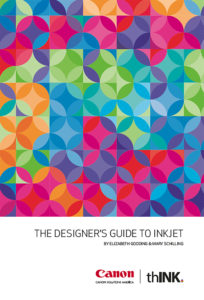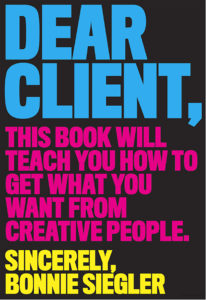Marketing professionals struggling to bridge the gap between their designers and print service providers have two great new resources for improving that crucial relationship – the Designer’s Guide to Inkjet, 2nd Edition, and Dear Client.


The second edition of The Designer’s Guide to Inkjet takes up twice as much shelf space as the first edition and is one instance where bigger is definitely better. The Guide grew by 100 pages in four years, which seems like a metaphor for the growth of the production inkjet platform. Of course, many of the basics have not changed and that includes the premise of one of my favorite chapters in the first edition.
The original title for Chapter Five was “You and Your Print Provider – Working in Harmony.” Now Chapter Six, it has a more playful title: “Printers Are People Too.” The new chapter begins with the word “COMMUNICATE” in 72 pt. type in a bright magenta banner. As the authors, Elizabeth Gooding and Mary Schilling stated in 2014 and repeated in 2018, “Communication with your print service provider is vital. Developing a good relationship with your print partner will save time and frustration for both of you throughout the process.”
This advice reminded me of another great read from 2018, written by Bonnie Siegler – Dear Client. Important messages appear in magenta there, too, with this bright pink subhead on the cover: “This book will teach you how to get what you want from creative people.”
Dear Client also stresses the importance of communication with this advice: “If you are open and honest from the outset, we [the creative team] will go above and beyond our obligations. The more we understand your goals, the approval process, and how your company works, the more we will surpass expectations. Give us the information and the space to do what we do best, and you should be very pleased with the results.”
Relationships Need Nurturing (and Nourishment)
One of the reasons the original Designer’s Guide was so valuable was because it was a fun read. The authors inserted humor and wry observations throughout the book and that pattern continues in the second edition. The last sentence of the “relationship” chapter in the first edition said, “Plus we took them to dinner.” One of the subheads in the second edition reads, “Where’s the best place for lunch?” You won’t find a QR code that takes you to Yelp (something to consider for the next edition?), instead, there is more common-sense advice about the value of getting away from a busy work environment. That section ends with, “Oh, and food is the fastest way to a printer’s heart.”
Dear Client continues the food theme with a chapter titled, “Serve Lunch During Lunchtime Meetings.” Once again, common sense prevails as the author reminds her readers that “It’s hard enough for a roomful of people to focus and cooperate long enough to accomplish anything. Hunger and its corresponding grumpiness exponentially lessen any chance of accomplishment.”
How to Get What You’re Really Asking For
Read both books from cover to cover and you will be reminded often of the importance of asking questions. As someone said long ago, “The only stupid question is the one you don’t ask.” It’s also clear that the way a question is asked has an influence on how satisfied you will be with the answer. Taking a page from the Eat This, Not That books, Dear Client includes a chapter titled, “Don’t Say That, Say This.”
Here are some great tips from that chapter that should be considered when talking to print service providers, especially when discussing production inkjet projects. As the Designer’s Guide reminds readers, “Most inkjet technology does not allow you to make adjustments such as print placement changes or color ‘tweaks’ on the press. This means that any print alterations must be done upstream at the RIP, or within the original design file.” Dear Client provides further guidance for discussing those changes:
“Don’t Say: Make it red.
Do Say: I wish it were bolder and stronger.
Don’t Say: Here are the changes we want you to make.
Do Say: Great effort, but there are some concerns we’d like addressed.
Don’t Say: We want it to look like this.
Do Say: Here are some examples of work we like and think is relevant.”
The technical tips throughout the Designer’s Guide are invaluable, but the authors deserve an extra pat on the back for reminding us about the human side of printing, too. Thanks also to Canon and thINK for sponsoring the second edition of the Designer’s Guide. Make room on your shelf for it.
About Debora Haskel:

Debora Haskel is vice president of marketing and corporate communications at IWCO Direct. She is also the marketing leader for Mail-Gard, a division of IWCO Direct with a 20-year history of providing business continuity and disaster recovery services. Debora uses her knowledge of all channels and leverages her extensive direct mail experience to help clients increase their return on marketing investment (ROMI) and protect their critical communications programs. She is an executive member of the DMA’s new Council for Print in the Digital Age and is a regular author and speaker. She can be reached at debora.haskel@iwco.com.
